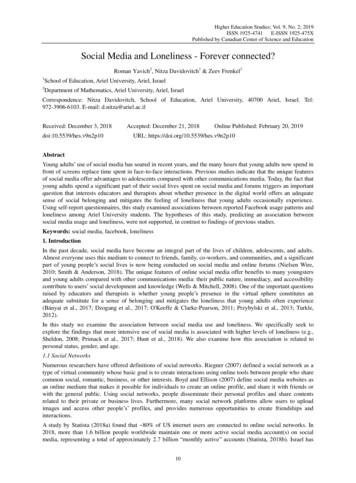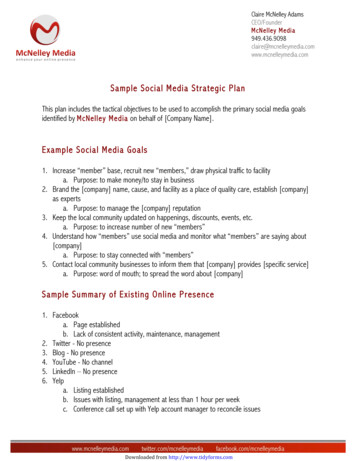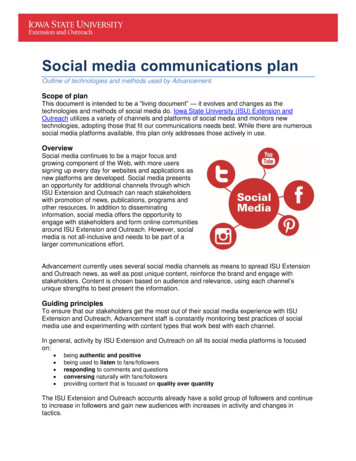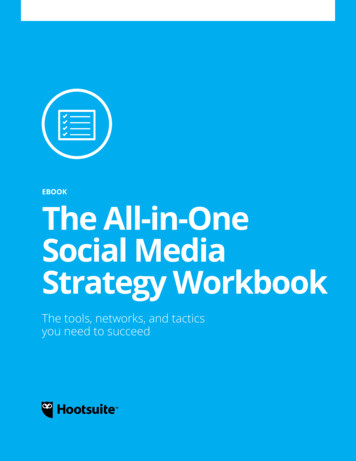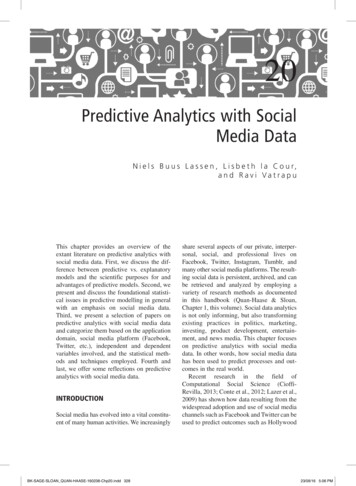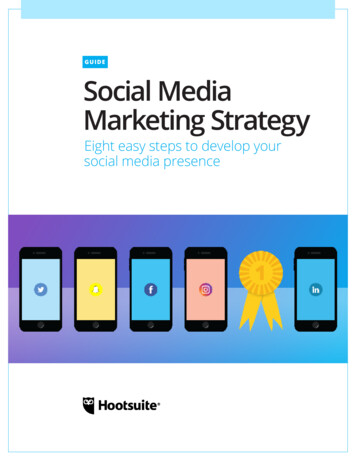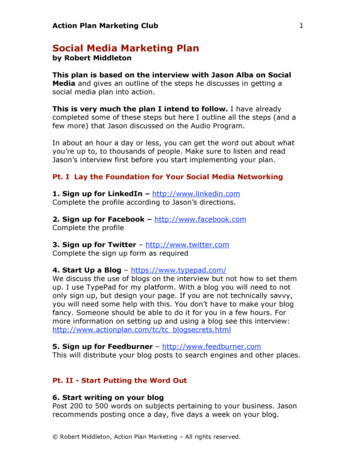
Transcription
www.ijemr.netISSN (ONLINE): 2250-0758, ISSN (PRINT): 2394-6962Volume-7, Issue-5, September-October 2017International Journal of Engineering and Management ResearchPage Number: 262-272The Impact of Social Media on Brand Awareness(With Special Reference to Facebook Use in Fast Moving ConsumerGoods in Sri Lanka)Upeksha. A. S. YapaDepartment of Management Sciences, Uva Wellassa University, SRI LANKAABSTRACTToday, traditional media is still a significant partof advertising strategies, but they cannot reach out to allmembers of the target audience on their own. In otherhand, social media platforms, such as Facebook, Twitterand YouTube, also use as marketing strategy to enhancebrand communication and promote and propagate productinformation among consumers in an efficient manner. Aswell as the trend of exerting social media platforms whichFMCG industry carries out has a significant control overbrand awareness and brand building. Therefore, this studyhas endeavored to fill the gap in marketing strategies, byexamining the impact of social media marketing on brandawareness, with reference to Facebook use in fast movingconsumer goods industry in Sri Lanka. The study samplewas made of 200 people, both male and female, who residein the Colombo district, use Facebook and have alreadyliked at least one fast moving consumer goods brand. Astandardized online survey was conducted via Google Docsby employing the convenience sampling technique to collectdata. The researcher has analyzed data concerning UserGenerated Communication and Firm GeneratedCommunication which are main two components of socialmedia marketing as the independent variables and brandawareness as the dependent variable to look at thecorrelation between these factors. The results has foundthat User Generated Communication and Firm GeneratedCommunication have a positive correlation and impactwith brand awareness. Hence, the conclusion has given associal media efforts positively influence brand awareness inFMCG industry. Thereby, the study has suggested to buildplatforms to enhance consumer’s engagement on creatinguser generate contents for their brands, create and increasemore brand related and unrelated communication,combining traditional media with social media, achievingcompany target audience through Content/Adds/Apps to bemore cost effective, have excellent brand management andgood customer base.Keywords-- Firm Generate Communication, Purchaseintention, User Generate Communication, FacebookI.262INTRODUCTIONSocial media has become an integral part of theinternet and our daily lives. It manifests itself in manydifferent ways, with the term capturing a range of onlineplatforms that are intended to facilitate globalcommunication. Through using social media, everyonecan create and share content among friends or globally tostrangers, meaning it is now one of the greatest tools forspreading information around the world. Popular socialmedia networking sites like Facebook, Instagram.Twitter, LinkedIn, and other content communitiesprovide a platform for people to create and share contentinside and outside of their professional context. Thismakes social media an invaluable tool for marketers, asit is a way for customers to share information, and formarketers to create awareness and empowerment for abrand to their customer base.Social networking‘s power becomes apparentwhen looking at statistics, which demonstrate that it isnow a global movement. Globally, the rate of those witha social media account is now 61%. Social networkshave a faster rate of growth and usage than other onlineforms such as blogs and user groups (Hutton & Fosdick,2011). Foster Research found that in 2008, 75% ofInternet users were active on "Web-based socialnetworking" sites, such as blogs, online shopping sites ornetworks intended for socializing. This is up from 56%the year before. This activity included participating onsocial networks, reading websites or blogs, orcontributing reviews and ratings to online shopping sites(Kaplan and Haenlein, 2010).Brand Reputation is everything for a marketer.This is because if there are no other factors such asquality or price separating two brands, users will chooseto purchase one over the other because of its brandreputation. Therefore, companies must differentiate andposition its brand name so that it is clear for its targetmarket. Sometimes, visibility and recognition can be allthat separate two brands. Users are now increasinglyusing social media to discuss brands and products,making reference to their functional performance as wellas their social popularity (Kotler et al, 2010). Marketersshould utilize this social power by encouragingCopyright 2017. Vandana Publications. All Rights Reserved.
www.ijemr.netISSN (ONLINE): 2250-0758, ISSN (PRINT): 2394-6962consumers to engage with the brand in a positivemanner. By using web-based social networking in aproductive, well-considered way, firms have a way tocreate a strong online presence for themselves, andthereby be in a better position to offer believableperspectives on issues (Kotler and Keller, 2012).II.RESEARCH PROBLEMSri Lankan organizations spend around 56billion rupees a year on traditional media advertising(Athukorala, 2012). It is evident that Sri Lankanorganizations invest significantly in both social andtraditional media. However, it is still unclear what kindof impact social media has on brand awareness in SriLanka, because the existing literature does not provideempirical evidence that is unique to Sri Lanka.To frame our understanding of Sri Lanka, othercountries can be analyzed to understand the concepts.According to Balas (2014), social media hassignificantly increased brand awareness in Romania,while Jokinen (2015) found that social media caninfluence the overall impression of a brand‘s image.Factors such as using a site, the engagement of it, andthe experience of users, related associations and a user‘sawareness of a brand all have a positive impact on thebrand image (Nikolova 2012). Additionally, Maria(2010) mentions that even though there is a huge boomin the use of social networking sites such as Facebook,the research itself is lagging behind this rapiddevelopment, making it difficult to find recent studies onsocial media‘s relationship with the branding process.By taking all these facts into consideration, furtherresearch can assist in filling in this gap in the existingliterature, and thereby identify the impact of socialmedia marketing on brand awareness in fast movingconsumer goods in Sri Lanka.III.RESEARCH QUESTIONSWhat is the impact of User GeneratedCommunication on Facebook on brand awareness in fastmoving consumer goods industry in Sri Lanka?What is the impact of Firm GeneratedCommunication on Facebook on brand awareness in fastmoving consumer goods industry in Sri Lanka?IV.RESEARCH OBJECTIVESTo observe and analyze the impact of UserGenerated Communication in Facebook on brandawareness in fast moving consumer goods industry in SriLankaTo observe and analyze the impact of FirmGenerated Communication in Facebook on brandawareness in fast moving consumer goods industry in SriLankaREVİEW OF THE LİTERATUREV.263Social Networking Sites and Social MediaAccording to Boyd & Ellison (2007), SocialNetworking Sites (SNS) are a key factor to create onlinecontent and share users who share common interests.These social networking sites are often made up of userprofiles where registered members can share informationon their profiles or with others. Users will create theircontent, such as adding photos or writing messages orwill consume and share the content of others. Socialmedia users can add their contacts to their social medianetworks by sending invitations. This invitation can beaccepted or reject by other party. If the other partyaccepts the request, they become friends on the socialnetwork, and they can see each other activities which areshared on social network sites. (Kietzmann et al., 2011).Because of their potential to become viral and spread toa large audience, social networking sites are seen as avital tool for marketers to communicate with consumersand promote products (Tsai & Men, 2012). Therefore,having a broad social media presence is required for anybrand as social media is a place where consumers spendmost of their time on social media networks (Darragh,2015).Social media can be defined in many ways.Some of the definitions are listed below:1. Social Media is a tool which people use forsocial purposes (Safco, 2010).2. Atypeofonlineword-of-mouthcommunication, when compared with its effecton consumer attitudes to real word-of-mouthcommunication (Rothschild, 2011).3. A term for the range of information that isproduced, initiated, spread and consumed by auser online, with the purpose of informing theirsocial network about products, brands, services,people and issues (Blackshaw & Nazzaro,2006).Combining the above definitions, the researcherconcludes social media as a website hosted on theinternet which enables users to post content and sharethem with their friend's network.The Dimensions of FacebookEven though there are numerous socialnetworks online, this researcher has decided to selectFacebook as the primary social media to conduct thisstudy.Facebook is designed to create an open andconnected global community, with users using theFacebook platform to stay connected with friends andfamily, stay informed on global events and express theirpersonalities (Facebook, 2004). On Facebook, users canpresent themselves in an online profile. When they arebecome ―friends,‖ they can post comments, links andphotos on each other‗s pages and message their friends.Facebook users can also join groups on the platformbased on common interests and hobbies, or ineducational groups based on different interests. Usersalso have the option of listing their hobbies, interests andfavorite movie and music genres on their profiles toCopyright 2017. Vandana Publications. All Rights Reserved.
www.ijemr.netISSN (ONLINE): 2250-0758, ISSN (PRINT): 2394-6962share their personality with their friends (Ellison et al,2007).According to Weinberg (2009), a businessFacebook page is a platform which works as a Facebookpublic profile that enables businesses to share theirproducts or services with people that have Facebookaccounts. These pages are similar to personal profiles,although it differs in the fact that businesses are focusedon growing their fan base instead of the friend list. In thefunctions of a page, marketers can post and collectcontent, share content from their Twitter accounts orblogs, display user reviews and initiate conversations.Weinberg also noted that users could demonstrate theirliking of many brands and companies by engaging withFacebook fan pages aimed at a particular brand orcreating their own fan page. Facebook groups areanother way for users to publicly state their interest orliking of a particular cause, product, business, or brand.Facebook also has advanced advertising mechanismswhich are ideal for businesses, it enables to targetspotential customers based on demographics such as age,gender, location, relationship status, and interests(Giesen, 2007).User Generated CommunicationFacebook content can be divided into twodifferent categories, being either user-generated or firmgenerated. User Generated Communication is whereusers create or share content, and Firm GeneratedCommunication is when firms do with the intent ofpromoting their business on Facebook (Kurian, 2016).According to the Valcke & Lenaerts (2010), the termUser Generated Communication (UGC) first came intousage around 2005. Since then, UGC has continued to bea crucial part of the social media landscape. The entireworld is now capable of producing online content due tothe increased accessibility of broadband technology andelectronic gadgets, meaning more people can becomeactive participants in the Web 2.0 and participate inUGC. However, Valcke & Lenaerts have noted that it‘shard to define UGC because there is no officiallyaccepted mainstream definition. However, UGC can bedefined as all content posted online by users, which theyhave created themselves or by other which they aresimply sharing. This can be anything from text tographics, audio or video, or any combination of theabove. UGC can also give users the freedom to engagein hate speech or defamation, invade privacy, infringe onintellectual property (Cocozzelli, 2006).Having compiled the literature on UGC,Christodoulides, Jevons & Bonhomme (2012) haveidentified co-creation, empowerment, community, andself-concept as the factors that motivate users to generatetheir content and communication. Co-creation includesany situation where consumers collaborate withcompanies or other consumers to create online content(Humphreys & Grayson, 2008). Today there is a trendamong consumers to express their brand related opinionswith companies or with their friends. This can be used tounderstand consumer needs and wants and fulfill them.(Wright et al, 2006). UGC provides these people an264opportunity of expressing themselves by sharing theirideas, opinions, and interests with others. This becauseUGC also has a social dimension, which serves as a wayfor self-presentation and creating one‘s identity,allowing users to feel validated and recognized by theirpeers (Christodoulides et al, 2012).UGC involvement can be identified as a type ofproduct involvement because it is brand-related(Michaelidou & Dibb, 2008). Interviews conducted inprevious studies have confirmed that brands use andencourage UGC as a way to build relationships withconsumers. In the same vein, negative UGC can alsohave a harmful impact on a brand‘s reputation andequity. This is made worse by the fact that many usersconsider UGC more credible than professional content orFGC (Cheong & Morrison, 2008).Firm Generated CommunicationFirm Generated Communication is the othertype of content created on Facebook. This can be definedas any content created by a firm or brand to promotethemselves on Facebook to consumers (Kurian,2016).Facebook has a great native advertising platformwhich is an excellent way to reach both customers andpotential customers. Advertisements can be targeted atspecific customer bases by location, interests,employment, and education. Marketers can decide andadjust their own budgets, as web advertisement can bebought by cost per mile or cost per click (Adams, 2012).According to Hof (2011), Facebook has a great reachcapacity, as on average, people have a social network of130 Facebook friends. This means that when they "Like"a brand, that public affirmation of support may appearon the news feeds of several of their friends, who maydecide to spread it to their networks, thereby potentiallyspreading it to thousands in just a few moments. Hofalso found that people are two times as likely toremember an advertisement if their friend is in it. Theunit of branded content is also known as a social-mediabrand impression. There are a variety of channels thatthese impressions may happen, but there are fivevehicles that are used in particular to deliverimpressions:Publishing on pages: These impressions are unpaid andappear on the walls of fan pages, and may also appear inthe newsfeed of a fan or the fan‘s extended socialnetwork (Tag, 2015).Friend’s stories: These impressions, also unpaid, occurwhen a user directly engages with a brand, and theirfriends or friends of friends either see this on theirnewsfeed or their wall. An example of this may besomeone liking Columbia Sportswear, with their friendsseeing this (Smith, Fischer and Yongjian, 2012).Sponsored stories: These impressions are paid, and aresimilar to friend‘s stories. But the key difference is thatstory is visible for a wider audience than average postreach (Lipsman et al., 2012)Advertisements with social: These messages arebranded, coming straight from advertisers. Thesemessages are in a social context and appear to friends offans (Lipsman, Mudd, Rich, & Bruich, 2012).Copyright 2017. Vandana Publications. All Rights Reserved.
www.ijemr.netISSN (ONLINE): 2250-0758, ISSN (PRINT): 2394-6962Apps: Facebook has numerous apps which can be usedby marketers. These apps provide a vehicle that has greatpotential for going viral. Facebook also allowsdevelopers to create custom apps for their specific needs(Zarrella & Zarrella, 2011).Brand awarenessBrand awareness is defined as the consumer‘sability to identify a brand when presented to them in adifferent conditions. Brand awareness is increased byone‘s exposure to seeing it, hearing the name or thinkingabout it. Therefore, any efforts that marketers take suchas designing a symbol, logo, character, packaging oradvertising and promotions with slogans can increase theconsumer‘s familiarity and awareness of a brand(Macdonald & Sharp, 2000).Brand recognition is the consumer‘s ability toconfirm that they have been previously exposed to abrand when given it as a prompt. Brand recall is whenthe consumer can name a brand from their memory whenprompted by a product category or the purpose of thatcategory, or purchase or usage situation (Parameswaran,Keller, & Jacob, 2012).According to Brewer & Zhao (2010) brandawareness is key determinants to identify consumerbehavior.Consumers tend to purchase a product withhigher brand awareness, rather than base theirpurchasing decision on quality or price.Brand awareness motivates consumers to takepurchase decision quicker.Brand awareness also has a strong influence onwhether or not the consumer chooses to purchase fromthe same brand again.There are also other studies to support theseclaims regarding social media, such as Hutter et al.(2013) who found that Facebook fan pages have apositive effect on consumer brand awareness, and TomiJokinen (2016) found that social media impact on brandawareness is equivalent to traditional media.Social Media and Fast Moving Consumer Goodsindustry in Sri LankaAccording to research compiled by BartleetReligare Securities (2012), Sri Lanka Fast MovingConsumer Goods market has been grown rapidly in thepast few years. Now there is high competition amongmanufacturers to provide quality products at normalprice range. Sri Lanka‘s FMCG market amount to Rs.141 billion during 2010. 74% of the market comprises offood and beverage companies, with personal care andhome care having a market share of 15% and 11%respectively.265Social Media is also a huge part of the averageSri Lankan‘s life, with a majority of the populationspending a significant amount of time on Facebook, aswell as other social networks (Sri Lanka Social MediaSurvey, 2013).According to McGiboney (2009), the estimatedonline advertising spending of marketers on the mostpopular social media and blogging sites increased 11%,from approximately 49 million in August 2008 to about 108 million the following August. The share of the totaladvertising budget dominated by social mediaadvertising also grew, going from a 7% share of the totalonline advertisement budget in August 2008 to a 15%share the same time the following year.Additionally, a Nielsen Media Research studyin June 2009 found that the spending of major FMCGbrands on online display advertisements had fallen11.4% in the first quarter of 2009, which indicates thatbrands are increasingly investing their money into socialmedia. These brands are doing so because it is a way todirectly build relationships with consumers (Smith,2010).However, what this means for the Sri Lankanmarket and the efficacy of Sri Lankan companies‘ socialmedia use is still something to be investigated further.VI.METHODSIn this study, the researcher has used deductiveresearch strategy since the research is based on existingtheories of User Generated Communication, FirmGenerated Communication, and Brand Awareness.Under deductive strategy, the researcher has used aquantitative approach to collect and analyse data asresearch objectives are to measure the impact of twovariables and to establish find the relationship betweentwo variables. By using quantitative approach, it enablesto find out empirical evidence on impact and relationshipof User Generated Communication and Firm GeneratedCommunication on Brand Awareness using statisticalanalyses. This study targets all consumers in Sri Lankawho use Facebook and have liked at least one FMCGbrand prior to the study taking place. A sample size ofthe study is 200 respondents, who are conveniently ableto provide the information and Colombo district selectedas the extent of the study as Colombo District having thehighest population who are using the internet and socialmedia. The researcher is employing the conveniencesampling technique.Copyright 2017. Vandana Publications. All Rights Reserved.
www.ijemr.netISSN (ONLINE): 2250-0758, ISSN (PRINT): 2394-6962HypothesesHypotheses stated in the above conceptual frameworkcould be explained as follows;H1: User Generated Communication will positivelyaffect brand awareness.H2: Firm Generated Communication will positivelyaffect brand awareness.Variable DefinitionVariables included in the conceptual frameworkare defined belowIndependent VariablesUserGeneratedCommunication:UserGenerated Communication (UGC) is defined as allonline content generated or posted by users, whetherthey created it or not. This can be in the form of text,graphics, audio, video or any combination of the above(Valcke & Lenaerts, ommunityFirmGeneratedCommunication:FirmGenerated Communication (FGC) can be defined as allcontent which is upload to the internet by firms topromote their brands. Firm Generated Communicationmeans, contents that are published by firms to promotetheir brand on Facebook. (Kurian, 2016)Dependent VariableBrand Awareness: The potential buyer‘sability to identify or ability to remember brands from acertain product category can be defined as brandawareness. (Aaker, 1991)Operationalization of VariablesThe above-defined variables of the study couldbe divided into observable measures as presented inTable.Table 1: Operationalization of VariablesMeasureI sense community feeling when I postunique content about a brand.Source(Christodoulides, Jevons,&Bonhomme,2012)I involve with other members online, due tocommon interest in a brand.I am encouraged to produce content about abrand because of my association in a socialmedia network.I express myself online through brands.FirmGeneratedCommunication266Concept of theSelfMy relationship with a brand expresses moreabout myself.PublishingPageI like to comment on social media postsgenerated by a brand.I use social media to share a brand‘s posts(photos, videos, links and polls) with myfriendsI am encouraged to produce content about abrand because of my membership in a socialnetwork.on(Zarrella & Zarrella,2011)Copyright 2017. Vandana Publications. All Rights Reserved.
www.ijemr.netBrand AwarenessISSN (ONLINE): 2250-0758, ISSN (PRINT): 2394-6962AppsI often start using an app if a brand postsabout it.RecognitionI can recognize the brand.I can tell the brand from among itscompetitors.I can remember the name of the brandquickly whenever I see its backgroundpictures.I can think of key characteristics of the brandquickly whenever I see itI can effortlessly imagine what the brand/slook likeRecallData CollectionThe most important data collected in this surveyis primary data, which has been collected by conductinga questionnaire completed by 200 respondents. Thequestionnaire primarily asked questions about cation and their involvement in FirmGenerated Communication, as well as gatheringdemographical information on the respondents.Thequestionnaire was created and distributed via GoogleDocs (docs.google.com), which proved to be aconvenient and flexible way to conduct the survey. Thequestionnaire was promoted on Facebook and was set upin such a way that users who tried to access the surveyfrom outside of Colombo could not do so.Data AnalysisThe SPSS Statistical data analysis method willbe utilized to analyze data which are gathered in thisresearch. This will allow the researcher to drawdisruptive statistics, correlation coefficient analysis andmultiple regression estimates. Visual aids such as(Yoo,2000)Donthu,&Lee,graphs, tables, and charts are also used to represent thesummarized data in a graphical way. The followingmultiple regression models are used in drawingstatistical evidence to test hypothesized relationships ofthe study:BAi β0 β1 UGCi β2 FGCi εiWhere;BAi Brand Awarenessβ0 ConstantUGC User Generated CommunicationFGC Firm Generated Communicationεi Error TermVII.PRESENTATİON AND ANALYSİSOF DATAPresentation of sample demographicsThis section presents responses received forrelated questions raised by demographic data.Figure 1: GenderAccording to the analysis sample, malesdominate in the gender composition. 66.5% of thesample respondents are males, while only 33.5% are267females. According to Facebook Sri Lanka‘s statistics,males make up 70% of the social media platform‘s users,while females represent only 30% of the user base.Copyright 2017. Vandana Publications. All Rights Reserved.
www.ijemr.netISSN (ONLINE): 2250-0758, ISSN (PRINT): 2394-6962Figure 2: AgeThe largest demographic in this study is the 2534 age category, which comprises 48% of therespondents. Meanwhile, 24.5% of the respondents areabove 35 and 23.5% respondents are in the 18-24 agecategory. According to the Facebook statics Sri Lanka,25-34 age categories represent 33% of the entire base ofSri Lankan Facebook users.Figure 3: EducationCompleted Postgraduate DegreeCompleted First DegreePassed Advanced LevelPassed Ordinary LevelUp to Grade 8No Formal Education020406080100120EducationMost of the respondents have completedadvanced level followed by the first-degree category.Since the most respondents in sample age are 25-34, itseems that most of them are knowledgeable and aware of268technology. Respondents who do not have any formaleducation and passed only up to grade 8 shows lowvalue, indicating a poor knowledge of new technology.Copyright 2017. Vandana Publications. All Rights Reserved.
www.ijemr.netISSN (ONLINE): 2250-0758, ISSN (PRINT): 2394-6962Figure 4: OccupationThe largest proportion of the sample, 62%, areemployed. This could be because many Sri Lankansbrowse the internet while at work.Realiability TestBefore progressing to the correlation andregression analysis, the researcher attempted to verifythe suitability of the collected data to be used in theanalysis. Accordingly, the researcher used Cronbach'salpha reliability test to validate the internal reliability ofthe questionnaire. If the alpha value more than 0.7, thetest can be considered as significant.Table 02: Cronbach's Alpha Reliability TestVariableNumber of QuestionsCronbach's AlphaUser Generated Communication050.900Firm Generated Communication040.875Brand Awareness050.915According to Table 01, Cronbach‘s alpha valueis higher than 0.7 for all variables. Therefore thereliability of the questionnaire can be considered asacceptable.Correlation AnalysisThe purpose of the correlation analysis is tofind out first phase statistical evidence to test thehypotheses of the study.Table 03: Correlation Analysis between User Generated Communication and Brand AwarenessUser Generated Brand arson CorrelationSig. arson CorrelationSig. (2-tailed)200.753**.0002001N200**. Correlation is significant at the 0.01 level (2-tailed).There is a strong correlation between UserGenerated Communication and brand awareness: 0.753at a significant level of 0.01 as shown in table 18. The269200Pearson Correlation is 0.753, which confirms that thereis a strong correlation between User GeneratedCommunication and brand awareness.Copyright 2017. Vandana Publications. All Rights Reserved.
www.ijemr.netISSN (ONLINE): 2250-0758, ISSN (PRINT): 2394-6962Table 04: Correlation Analysis between Firm Generated Communication and Brand AwarenessFirmGenerated Brand AwarenessCommunicationFirmGenerated Pearson Correlation1.754**CommunicationSig. (2-tailed).000N200200Brand AwarenessPearson Correlation.754**1Sig. (2-tailed).000N200200**. Correlation is significant at the 0.01 level (2-tailed).There is also a positive connection betweenFirm Generated Communication and brand awareness, asevidenced by the Pearson Correlation of 0.754 and thesignificant level of 0.01.ModelConstantUser Generated CommunicationFirm Generated CommunicationAdjusted R2F statisticTable 05: Regression AnalysisBAi β0 β1 UGCi β2 FGCi εiCoefficientSignificance (P value)0.925.000.404.000.408.000.617161.542.000The Coefficients in Table 20 revealed theintercept (β0) equals 0.925. The impact of UserGenerated Communication (β1) and Firm GeneratedCommunication (β2) are .404 and 0.408 respectively.These results indicate that when there is a 1 unit ofchange in a User Generated Communication, there willbe a 0.404 unit increase in brand awareness, and whenthere is a 1 unit of change in a Firm GeneratedCommunication, there will be a .408 increase in brandawareness.The p-value for User GeneratedCommunication and Firm Generated Communication is0.000, which suggests that the above influences arehighly statistically significant. Accordingly, theestablished hypothesis in the correlation analysis can beconfirmed.According to the table 20, the coefficient ofdetermination (R2) is 0.617. It shows that 61.7% of thevariation in the brand awareness could be explained bythe User Generated Communication and Firm GeneratedCommunication variables.The p-value of the F –statistic table is 0.000which is less than 0.05. Therefore the model developedand used in this study can be used as an efficient modelfor estimating the impact of brand awareness on UserGenerated Communication and Firm GeneratedCommunication in Social Media. Further, it ensures thevari
having a broad social media presence is required for any brand as social media is a place where consumers spend most of their time on social media networks (Darragh, 2015). Social media can be defined in many ways. Some of the definitions are listed below: 1. Social Media is a tool which people u



